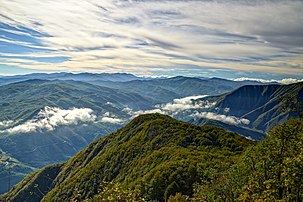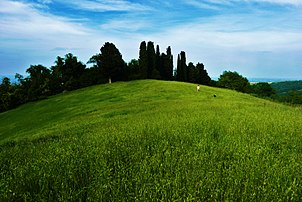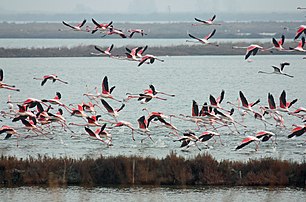
A | B | C | D | E | F | G | H | CH | I | J | K | L | M | N | O | P | Q | R | S | T | U | V | W | X | Y | Z | 0 | 1 | 2 | 3 | 4 | 5 | 6 | 7 | 8 | 9
This article's factual accuracy may be compromised due to out-of-date information. (April 2023) |
Emilia-Romagna
| |
|---|---|
|
| |
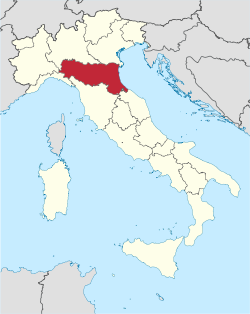 | |
| Country | Italy |
| Capital | Bologna |
| Government | |
| • President | Stefano Bonaccini (PD) |
| Area | |
| • Total | 22,446 km2 (8,666 sq mi) |
| Population (2010-11-30) | |
| • Total | 4,446,220 |
| • Density | 200/km2 (510/sq mi) |
| Demonym(s) | English: Emilia-Romagnan Emilian: Emigliàn (man) Emilian: Emiglièna (woman) Romagnol: Rumagnòl (man) Romagnol: Rumagnòla (woman) Italian: Emiliano (man) Italian: Emiliana (woman) or Italian: Romagnolo (man) Italian: Romagnola (woman) |
| GDP | |
| • Total | €163.293 billion (2021) |
| Time zone | UTC+1 (CET) |
| • Summer (DST) | UTC+2 (CEST) |
| ISO 3166 code | IT-45 |
| NUTS Region | ITH[2] |
| HDI (2022) | 0.940[3] very high · 1st of 21 |
| Website | www |
Emilia-Romagna (UK: /ɪˌmiːliə roʊˈmɑːnjə/, US: /eɪˌmiːljə/, both also /ɛˌmiːljə -/;[4][5][6][7] Italian: [eˈmiːlja roˈmaɲɲa]; Emilian: Emégglia-Rumâgna or Emîlia-Rumâgna; Romagnol: Emélia-Rumâgna) is an administrative region of northern Italy, comprising the historical regions of Emilia and Romagna. Its capital is Bologna. It has an area of 22,446 km2 (8,666 sq mi), and a population of 4.4 million.
Emilia-Romagna is one of the wealthiest and most developed regions in Europe, with the third highest gross domestic product per capita in Italy,[8][9] Emilia-Romagna is also a cultural, economic and tourist center, being the home of the University of Bologna, the oldest university in the world;[10] containing Romanesque and Renaissance cities, such as Modena, Parma and Ferrara, and the once Western Roman Empire's capital city, Ravenna; encompassing eleven UNESCO heritage sites;[11] being a center for food and automobile production (home of automotive companies such as Ferrari, Lamborghini, Maserati, Pagani, De Tomaso, Dallara, and Ducati); and having popular coastal resorts such as Cervia, Cesenatico, Rimini and Riccione. In 2018, the Lonely Planet guide named Emilia-Romagna as the best place to see in Europe.[12] The region is home to the third largest community of foreign residents in the country, after Lombardy and Lazio.[13]
Etymology
The name Emilia-Romagna is a legacy of Ancient Rome. Emilia derives from the via Aemilia, the Roman road connecting Piacenza to Rimini, completed in 187 BC, and named after the consul Marcus Aemilius Lepidus.[14] Romagna derives from Romània, the name of the Eastern Roman Empire applied to Ravenna by the Lombards when the western Empire had ceased to exist and Ravenna was an outpost of the east (540–751).[citation needed]
History
This section needs additional citations for verification. (August 2023) |

Prehistory and antiquity
Before the Romans took control of present-day Emilia-Romagna, it had been part of the Etruscan world and subsequently that of the Gauls. During the first thousand years of Christianity, trade flourished, as did culture and religion, thanks to the region's numerous monasteries.
Early origins
The history of Emilia-Romagna dates back to Roman times when the region of Emilia was ruled by imperial judges linked to the nearby regions of either Liguria or Tuscany. After the fall of the Western Roman Empire in the 5th century, the Lombards, a Germanic tribe, founded the kingdom of Lombardy in northern and central Italy. This kingdom, which included the region known as Emilia, flourished until the Lombard dynasty was overthrown by the Frankish king Charlemagne in 774. From the 6th to 8th centuries, the region of Romagna was under Byzantine rule and Ravenna was the capital of the Exarchate of Italy within the Eastern Roman Empire. In the 8th century, this region became a province of the Papal States when Pepin, the father of Charlemagne, donated the land to the Pope in 754.
Renaissance to early modern period
During the 10th century, northern Italy became part of the Holy Roman Empire under the control of the Germanic leader Otto I. The Holy Roman emperors had varying degrees of control over northern Italy until the close of the Middle Ages. In the 12th century, the papacy extended its political influence and city states began to form in opposition to the Holy Roman emperors.
The northern cities, supported by the Pope, formed the Lombard League and reduced the influence of the ruling Hohenstaufen dynasty over their lands. Division between imperial partisans and their opponents created factions called the Guelphs and the Ghibelines which would divide the cities for centuries. For the next few centuries both Emilia and Romagna were ruled by papal legates or representatives of the Pope.
The University of Bologna—the oldest university in the world, established in AD 1088—and its bustling towns kept trade and intellectual life alive. Local nobility like the Este of Ferrara, the Malatesta of Rimini, the Popes of Rome, the Farnese of Parma and Piacenza, and the Duchy of Modena and Reggio, jostled for power and influence.
The House of Este gained a notable profile for its political and military might and its patronage of the arts: it left behind a vast heritage of splendid Renaissance palaces, precious paintings and literary masterpieces, such as the works of Ludovico Ariosto, Torquato Tasso and Matteo Maria Boiardo.
Following the rise of Napoleon, the region of Emilia came under French control.[15] After the Congress of Vienna in 1815, there was a growing movement for Italian national unity and independence. In 1848, a revolution in Vienna initiated uprisings against Austrian rule. The following decades saw uprisings in several regions and, in 1861, the Kingdom of Italy was established. During this Italian Unification, the territories of Emilia and Romagna would be incorporated into the new nation.
Late modern and contemporary
In the 16th century, most of what would become Emilia-Romagna had been seized by the Papal States, but the territories of Parma, Piacenza, and Modena remained independent until Emilia-Romagna became part of the Italian kingdom between 1859 and 1861.
After the First world war, Emilia-Romagna was at the centre of the so-called Biennio Rosso, a period of left-wing agitations that paved the way for Benito Mussolini's coup d'état in 1922 and the birth of the Fascist regime in Italy. Mussolini, a native of Emilia-Romagna, sponsored the rise of many hierarchs coming from his same region, such as Italo Balbo, Dino Grandi and Edmondo Rossoni.
Towards the end of the Second World War, Emilia-Romagna was occupied by Germany and has been the theatre of numerous Nazi war crimes, such as the Marzabotto massacre in which 770 innocent civilians were brutally executed by German troops.
During the Cold war era, Bologna, traditionally a left-wing city, was particularly hit by political street violence and terrorism; in 1980 a far-right terrorist group detonated a bomb at the city's main railway station, killing 85 people and wounding more than 200.
After the referendum of 2006, seven municipalities of Montefeltro were detached from the Province of Pesaro and Urbino (Marche) to join that of Rimini on 15 August 2009.[16][17] The municipalities are Casteldelci, Maiolo, Novafeltria, Pennabilli, San Leo, Sant'Agata Feltria and Talamello.
On 20 and 29 May 2012 two powerful earthquakes struck the central area of the region, killing 27 people and causing substantial damages to the region's artistic heritage as well as to numerous manufacturing facilities. The 5.8 magnitude earthquake left 14,000 people temporarily homeless.[18]
Geography
This section needs additional citations for verification. (August 2023) |


The region of Emilia-Romagna consists of nine provinces and covers an area of 22,446 km2 (8,666 sq mi), ranking sixth in Italy. Nearly half of the region (48%) consists of plains while 27% is hilly and 25% mountainous. The region's section of the Apennines is marked by areas of flysch, badland erosion (calanques) and caves. The mountains stretch for more than 300 km (186.41 mi) from the north to the south-east, with only three peaks above 2,000 m – Monte Cimone (2,165 m), Monte Cusna (2,121 m) and Alpe di Succiso (2,017 m).
The plain was formed by the gradual retreat of the sea from the Po basin and by the detritus deposited by the rivers. Almost entirely marshland in ancient times, its history is characterised by the hard work of its people to reclaim and reshape the land in order to achieve a better standard of living.
The geology varies, with lagoons and saline areas in the north and many thermal springs throughout the rest of the region as a result of groundwater rising towards the surface at different periods of history. All the rivers rise locally in the Apennines except for the Po, which has its source in the Alps in Piedmont. The northern border of Emilia-Romagna follows the path of the river for 263 km (163+1⁄2 mi).
The region has temperate broadleaved and mixed forests and the vegetation may be divided into belts: the Common oak-European hornbeam belt (Padan plain and adriatic coast) which is now covered (apart from the Mesóla forest in Province of Ferrara) with fruit orchards and fields of wheat and sugar beet, the Pubescent oak-European hop-hornbeam belt on the lower slopes up to 800–900 m, the European beech-Silver fir belt between 800–900 m and 1,700 m and the final mountain heath belt above 1,700–1,800 m. Emilia-Romagna has two Italian National Parks, the Foreste Casentinesi National Park and the Appennino Tosco-Emiliano National Park.
Land use
Emilia-Romagna has been a highly populated area since ancient times. Inhabitants over the centuries have radically altered the landscape, building cities, reclaiming wetlands, and establishing large agricultural areas. All these transformations in past centuries changed the aspect of the region, converting large natural areas to cultivation, up until the 1960s. The trend then changed, and agricultural lands began giving way to residential and industrial areas. The increase of urban-industrial areas continued at very high rates until the end of the 2010s. In the same period, hilly and mountainous areas saw an increase in the registration of semi-natural areas, because of the abandonment of agricultural lands.
Land use changes can have strong effects on ecological functions. Human interactions such as agriculture, forestation and deforestation affect soil function, e.g. food and other biomass production, storing, filtering and transformation, habitat and gene pool.[19]
In the Emilia-Romagna plain, which represents half of the region and where three quarters of the population of the region live, the agricultural land area has been reduced by 157 km2 while urban and industrial areas have increased to over 130 km2 between 2003 and 2008. The impact of land use and particularly of the urbanisation of the Emilia-Romagna plain during this period has had some strong consequences in the economic and ecological assessment of the region. The loss of arable land is equivalent to a permanent loss of the capacity to feed 440,000 persons per year from resources grown within the region. The increased water runoff due to soil sealing requires adaptation measures for river and irrigation canals such as the building of retention basins, at a total cost estimated in the order of billions of euros.[20]
In 2000 there were 103,700 farm holdings and in 2010 there were 73,470, or a -29.2% loss in holdings for the region. The total utilised agricultural area (UAA) was 1,114,590 hectares (2,754,200 acres) in 2000 and 1,064,210 hectares (2,629,700 acres) in 2014 for a loss of 4.5%, indicating a downturn of smaller farm ownership. During this same timeframe there was a 14.5% decrease in the farm labor workforce.[21]
Government and politics

The Regional Government (Giunta Regionale) is presided by the President of the Region (Presidente della Regione), who is elected for a five-year term. The Regional Government is composed of the President and the Ministers (Assessori), of which there are currently twelve including the Vice President and the Under-Secretary for the President's office.[22]
Apart from the province of Piacenza, Emilia-Romagna was historically a stronghold of the Italian Communist Party, forming the Italian "Red Quadrilateral"[23] or sometimes "Red Belt" called with Tuscany, Umbria and Marche. This is probably due to the strength of the anti-fascist resistance around the time of World War II as well as a strong tradition of anti-clericalism dating from the 19th century, when part of the region belonged to the Papal States. The strength of the anti-fascist resistance is one of the main factors, along with the effectiveness of trade-unionism, that led to the dominance of the PCI in the region.
Emilia-Romagna has since World War II been a left-wing stronghold, nowadays led by the Democratic Party, since its creation in 2007.
Administrative divisions

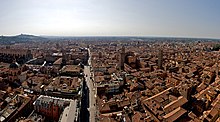
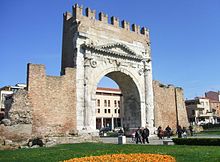
Emilia-Romagna is divided into nine provinces. Apart from the creation of the Metropolitan City of Bologna, plans to reduce the number of provinces from nine to four have been dropped.
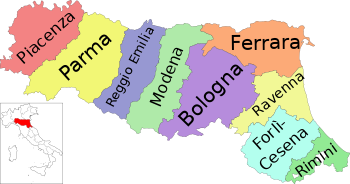
| Province | Area (km2) | Population | Density (inhabitants/km2) | Region |
|---|---|---|---|---|
| Metropolitan City of Bologna | 3,702 | 1,011,291 | 262.9 | Emilia - Romagna |
| Province of Ferrara | 2,632 | 357,471 | 135.8 | Emilia |
| Province of Forlì-Cesena | 2,377 | 387,200 | 162.9 | Romagna |
| Province of Modena | 2,689 | 686,104 | 255.1 | Emilia |
| Province of Parma | 3,449 | 431,419 | 125.1 | Emilia |
| Province of Piacenza | 2,589 | 284,885 | 110.0 | Emilia |
| Province of Ravenna | 1,858 | 383,945 | 206.6 | Romagna |
| Province of Reggio Emilia | 2,293 | 517,374 | 225.6 | Emilia |
| Province of Rimini | 863 | 325,219 | 377.0 | Romagna |
Demographics
| Year | Pop. | ±% |
|---|---|---|
| 1861 | 2,083,000 | — |
| 1871 | 2,228,000 | +7.0% |
| 1881 | 2,289,000 | +2.7% |
| 1901 | 2,547,000 | +11.3% |
| 1911 | 2,813,000 | +10.4% |
| 1921 | 3,077,000 | +9.4% |
| 1931 | 3,267,000 | +6.2% |
| 1936 | 3,339,000 | +2.2% |
| 1951 | 3,578,018 | +7.2% |
| 1961 | 3,692,787 | +3.2% |
| 1971 | 3,866,218 | +4.7% |
| 1981 | 3,977,104 | +2.9% |
| 1991 | 3,928,841 | −1.2% |
| 2001 | 4,003,196 | +1.9% |
| 2011 | 4,344,755 | +8.5% |
| 2021 | 4,425,366 | +1.9% |
| Source: ISTAT | ||
ISTAT estimates the population of Emilia-Romagna was 4,459,577 on 1 January 2019.[24] The population density, which was equal to 200 inhabitants per km2 in 2019, is close to the national average. The population of this region is traditionally evenly distributed, with no dominant metropolis but rather a line of medium-sized cities along the Via Emilia, where two thirds of the population and the majority of the industrial production are concentrated. The coast of Romagna is also densely populated due to the booming seaside tourism in recent decades. In the peripheral areas of the Apennine Mountains and the agricultural plains around Ferrara and Piacenza, the population is less dense.
Cities, towns and metropolitan areas
The region has nine cities with populations exceeding one hundred thousand: Bologna, Parma, Modena, Reggio Emilia, Ravenna, Rimini, Ferrara, Forlì and Piacenza. These cities rank among the 50 most populous in Italy. The regional capital, Bologna, has about 400,000 inhabitants and lies at the heart of a metropolitan area of about one million residents.
| Rank | Province | Pop. | Rank | Province | Pop. | ||||
|---|---|---|---|---|---|---|---|---|---|
 Bologna  Parma |
1 | Bologna | Bologna | 390,636 | 11 | Carpi | Modena | 71,836 |  Modena  Reggio nell'Emilia |
| 2 | Parma | Parma | 196,518 | 12 | Imola | Bologna | 69,798 | ||
| 3 | Modena | Modena | 186,307 | 13 | Faenza | Ravenna | 58,755 | ||
| 4 | Reggio nell'Emilia | Reggio nell'Emilia | 171,997 | 14 | Sassuolo | Modena | 40,918 | ||
| 5 | Ravenna | Ravenna | 157,663 | 15 | Casalecchio di Reno | Bologna | 36,512 | ||
| 6 | Rimini | Rimini | 150,576 | 16 | Cento | Ferrara | 35,474 | ||
| 7 | Ferrara | Ferrara | 132,052 | 17 | Riccione | Rimini | 35,181 | ||
| 8 | Forlì | Forlì | 117,798 | 18 | Formigine | Modena | 34,559 | ||
| 9 | Piacenza | Piacenza | 103,942 | 19 | Castelfranco Emilia | Modena | 33,059 | ||
| 10 | Cesena | Forlì | 97,210 | 20 | San Lazzaro di Savena | Bologna | 32,518 | ||
Immigration and ethnicity
| The largest resident foreign-born groups on 31 December 2019[25] | |
|---|---|
| Nationality | Population |
| 93,428 | |
| 60,680 | |
| 57,148 | |
| 31,895 | |
| 28,931 | |
| 26,363 | |
| 22,752 | |
| 18,319 | |
| 17,583 | |
| 15,632 | |
Between 1876 and 1976, about 1.2 million people emigrated from Emilia-Romagna to other countries. As of 2008[update], there were 119,369 people from this region living outside Italy, particularly in Argentina, Switzerland, France, the United Kingdom and Brazil.[26] As of 2008[update], the Italian National Institute of Statistics (ISTAT) estimated that 365,687 foreign-born immigrants lived in Emilia-Romagna, equal to 8.5% of the total regional population.
Language
Apart from standard Italian, Emilian and Romagnolo, two closely related languages that are part of the Emiliano-Romagnolo language family, are the local languages of Emilia-Romagna. They are Romance languages spoken in the region, in Northern Marche and other nearby areas such as parts of Massa-Carrara, Mantua, Pavia and Rovigo provinces and in San Marino. The Sillaro river (Emilian: Séllar in Emilian), near the town of Castel San Pietro Terme, is the border between Emilia and Romagna. They belong to the Northern Italian group within Romance languages (like Piedmontese, Lombard, Ligurian and Venetian), which is included in the wider group of western Romance languages (including French, Occitan and Catalan). They are considered minority languages, structurally separated from Italian by the Ethnologue and by the Red Book of Endangered Languages of UNESCO.
Economy

Emilia-Romagna today is considered one of the richest European regions and the third wealthiest Italian region by gross domestic product (GDP) per capita.[8] These results have been achieved by developing a very well balanced economy that comprises Italy's biggest agricultural sector as well as a long-standing tradition in automobile, motor and mechanics manufacturing and a strong banking and insurance industry.


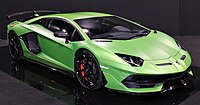

Agriculture
In spite of the depth and variety of industrial activities in the region, agriculture has not been eclipsed. Emilia-Romagna is among the leading regions in the country, with farming contributing 5.8% of the gross regional product. The agricultural sector has aimed for increased competitiveness by means of structural reorganisation and high-quality products, and this has led to the success of marketed brands. Cereals, potatoes, maize, tomatoes and onions are the most important products, along with fruit and grapes for the production of wine (of which the best known are Emilia's Lambrusco, Bologna's Pignoletto, Romagna's Sangiovese and white Albana). Alongside cereals, which for centuries remained the first local product, the cultivation of fruit trees has developed (especially peaches, but also apricots, plums, apples and pears).
Cattle and pig breeding are also highly developed. Farm cooperatives have been working along these lines in recent years. With their long tradition in the region there are now about 8,100 cooperatives, generally in the agricultural sector and mainly located in the provinces of Bologna (2,160) and Forlì-Cesena (1,300).[27]
Industry
The regional economy is more geared to export markets than other regions in the country: the main exports are from mechanical engineering (53%), the extraction of non-metallic minerals (13%) and the clothing industry (10%).[27] Industry in the region presents a varied and complex picture and is located along the Via Emilia.
The food industry (e.g. Barilla, Parmalat, Granarolo, Zanetti, Grandi Salumifici Italiani, Cremonini, Fini, Conserve Italia) is particularly concentrated in Parma, Modena and Bologna. Very important is production of Parma ham, Parmesan and Grana Padano cheeses, Modena balsamic vinegar, and Mortadella sausages. It is not restricted to these famous products, but also include production of sausages, other cheese, dairy products, coffee, sugar, fruit and vegetable conserves and stuffed pasta.
Automotive industry produces sports cars (Ferrari, Lamborghini, Maserati, Pagani), trucks (Astra), buses (Menarinibus) and motorcycles (Ducati, Bimota).[28]
Machine building is well-developed and represented with fork-lifts (OM Still, FMTH Fantuzzi), skid-steer loader (CNH Industrial), tractors (Argo, Goldoni, Arbos), motors (VM Motori, Lombardini), vehicle gas-fuel equipment (Landi Renzo), undercarriages (ThyssenKrupp Berco), ceramic machine (SACMI), packaging machine (Coesia, SACMI, IMA), pumps (Interpump), wood-working machine tools (SCM Group), home appliance (Smeg, Saeco), automatic data capture equipment (Datalogic) etc.
There is a chemical industrial park in Ferrara, where different companies manufacturing polyethylene, polypropylene, synthetic rubber and nitrogenous fertilizers. Other industrial park is Mirandola Biomedical District. In Parma there is pharmaceutical manufacturing from Chiesi Farmaceutici.
Sport and fitness articles is manufacturing by Technogym in Cesena.
The ceramic sector is concentrated in Faenza and Sassuolo.
Footwear industry is well developed and located in 2 industrial districts San Mauro Pascoli and between Fusignano and Bagnacavallo.
Tourism
Tourism is increasingly important, especially along the Adriatic coastline and the cities of art. The most popular location for seaside tourism is Rimini. Emilia-Romagna has many small and picturesque villages, 16 of them have been selected by I Borghi più belli d'Italia (English: The most beautiful Villages of Italy),[29] a non-profit private association of small Italian towns of strong historical and artistic interest,[30] that was founded on the initiative of the Tourism Council of the National Association of Italian Municipalities.[31]
Transport
The region of Emilia-Romagna has a very good system of transport, with 574 km of motorways, 1,053 km of railways and airports in Bologna, Forlì, Parma and Rimini. The main motorway crosses the region from north-west (Piacenza) to the south-east (Adriatic coast), connecting the main cities of Parma, Reggio Emilia, Modena, Bologna, and from here further to Ravenna, Rimini and the Adriatic coast.[27]
Unemployment rate
The unemployment rate stood at 5.1% in 2022 and was lower than the national average of 8.1%.[32]
| Year | 2006 | 2007 | 2008 | 2009 | 2010 | 2011 | 2012 | 2013 | 2014 | 2015 | 2016 | 2017 | 2018 | 2019 | 2020 | 2021 | 2022 |
|---|---|---|---|---|---|---|---|---|---|---|---|---|---|---|---|---|---|
| unemployment rate (in %) |
3.4% | 2.8% | 3.2% | 4.6% | 5.6% | 5.2% | 7.0% | 8.4% | 8.3% | 7.7% | 6.9% | 6.5% | 5.9% | 5.5% | 5.7% | 5.6%[33] | 5.1%[34] |
Culture
Cinema

Emilia-Romagna has given birth to a number of important filmmakers and actors and was the main setting for numerous important movies. Bernardo Bertolucci was a native from Parma and his 1976 masterpiece, 1900, was partially set in Emilia-Romagna. Federico Fellini, a native of Rimini, shot many movies in the region, among them Amarcord. Pier Paolo Pasolini, a native from Bologna, in addition to being a film director, was a poet, writer, and intellectual, who also distinguished himself as an actor, journalist, novelist, playwright, and political figure. Michelangelo Antonioni, a native of Ferrara, shot his 1964 movie Red Desert in Ravenna. Florestano Vancini, also from Ferrara, shot there his 1960 film Long Night in 1943. Pupi Avati, a native of Bologna, shot numerous movies in the region, including the 1976 horror-thriller The House with Laughing Windows. Marco Bellocchio, a native of Bobbio, near Piacenza, directed many award-winning movies, such as his 2009 biopic Vincere. Liliana Cavani, a native of Carpi, near Modena, became internationally known after the success of her 1974 feature film The Night Porter. In addition, actor and filmmaker Vittorio De Sica shot in Ferrara his 1970 movie The Garden of the Finzi-Continis. Other actors from Emilia-Romagna include Gino Cervi, who played Peppone in the Don Camillo 1950s–1960s movie series; Rossano Brazzi, who acted in numerous English-language films, including the 1954 drama film The Barefoot Contessa; and the 1980s comedy duo Gigi e Andrea.
Cuisine and gastronomy

Emilia-Romagna is considered one of the richest regions of Italy with regard to its gastronomic and wine-making tradition. The region is known for its egg and filled pasta made with soft wheat flour. Bologna is notable for pasta dishes like tortellini, lasagne, gramigna and tagliatelle which are found also in many other parts of the region in different declinations. The Romagna subregion is known as well for pasta dishes like garganelli, strozzapreti, sfoglia lorda and tortelli alla lastra. In the Emilia subregion, except Piacenza which is heavily influenced by the cuisines of Lombardy, rice is eaten to a lesser extent. Polenta, a maize-based dish, is common both in Emilia and Romagna. The celebrated balsamic vinegar is made only in the Emilian cities of Modena and Reggio Emilia, following legally binding traditional procedures.[35] Parmigiano Reggiano (Parmesan Cheese) is produced in Reggio Emilia, Parma, Modena and Bologna and is much used in cooking, while Grana Padano variety is produced in the rest of the region.
Zdroj:https://en.wikipedia.org?pojem=Emilia–RomagnaText je dostupný za podmienok Creative Commons Attribution/Share-Alike License 3.0 Unported; prípadne za ďalších podmienok. Podrobnejšie informácie nájdete na stránke Podmienky použitia.
Antropológia
Aplikované vedy
Bibliometria
Dejiny vedy
Encyklopédie
Filozofia vedy
Forenzné vedy
Humanitné vedy
Knižničná veda
Kryogenika
Kryptológia
Kulturológia
Literárna veda
Medzidisciplinárne oblasti
Metódy kvantitatívnej analýzy
Metavedy
Metodika
Text je dostupný za podmienok Creative
Commons Attribution/Share-Alike License 3.0 Unported; prípadne za ďalších
podmienok.
Podrobnejšie informácie nájdete na stránke Podmienky
použitia.
www.astronomia.sk | www.biologia.sk | www.botanika.sk | www.dejiny.sk | www.economy.sk | www.elektrotechnika.sk | www.estetika.sk | www.farmakologia.sk | www.filozofia.sk | Fyzika | www.futurologia.sk | www.genetika.sk | www.chemia.sk | www.lingvistika.sk | www.politologia.sk | www.psychologia.sk | www.sexuologia.sk | www.sociologia.sk | www.veda.sk I www.zoologia.sk



